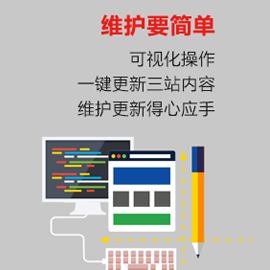在.netcore中如何實現(xiàn)字段和屬性注入-創(chuàng)新互聯(lián)
小編給大家分享一下在.net core中如何實現(xiàn)字段和屬性注入,相信大部分人都還不怎么了解,因此分享這篇文章給大家參考一下,希望大家閱讀完這篇文章后大有收獲,下面讓我們一起去了解一下吧!

簡單來說,使用Ioc模式需要兩個步驟,第一是把服務(wù)注冊到容器中,第二是從容器中獲取服務(wù),我們一個一個討論并演化。這里不會考慮使用如Autofac等第三方的容器來代替默認(rèn)容器,只是提供一些簡單實用的小方法用于簡化應(yīng)用層的開發(fā)。
將服務(wù)注入到容器
asp.netcore官方給出的在容器中注冊服務(wù)方法是,要在Startup類的ConfigureServices方法中添加服務(wù),如下所示:
public void ConfigureServices(IServiceCollection services)
{
services.AddMvc();
services.AddSingleton(typeof(UserService));
services.AddSingleton(typeof(MsgService));
services.AddSingleton(typeof(OrderService));
}AddMvc方法添加了mvc模塊內(nèi)部用到的一些服務(wù),這個是封裝好的,一句話就行了,其他第三方組件也都提供了類似的Add方法,把自己內(nèi)部需要的服務(wù)都封裝好注冊進去了。但是我們應(yīng)用開發(fā)人員使用的類,還是需要一個一個寫進去的,大家最常見的三層架構(gòu)中的數(shù)據(jù)訪問層和業(yè)務(wù)邏輯層便是此類服務(wù),上面代碼中我加入了三個業(yè)務(wù)服務(wù)類。這顯然不是長久之計,我想大家在開發(fā)中也會針對此問題做一些處理,這里說下我的,僅供參考吧。
解決方法就是批量注冊!說到批量,就需要一個東西來標(biāo)識一批東西,然后用這一個東西來控制這一批東西。在.net程序的世界中,有兩個可選的角色,一個是接口Interface,另一個是特性Attribute。
如果使用接口作為標(biāo)識來使用,限制就太死板了,一個標(biāo)識的信息不是絕對的單一,是不推薦使用接口的,因為可能需要引入多個接口才能共同完成,所以我選擇特性作為標(biāo)識。特性相較與接口有什么特點呢?特性在運行時是類的實例,所以可以存儲更多的信息。
下面我們簡單實現(xiàn)一個AppServiceAttribute:
/// <summary>
/// 標(biāo)記服務(wù)
/// </summary>
[AttributeUsage(AttributeTargets.Class, Inherited = false)]
public class AppServiceAttribute : Attribute
{
}這個特性類取名AppService有兩個理由,一是指定是應(yīng)用層的服務(wù)類,二是避免使用Service這樣的通用命名和其他類庫沖突。
有了標(biāo)識,就可以批量處理了,我們在一個新的類中給IServiceCollection提供一個擴展方法,用來批量添加標(biāo)記有AppService特性的服務(wù)到容器中。
public static class AppServiceExtensions
{
/// <summary>
/// 注冊應(yīng)用程序域中所有有AppService特性的服務(wù)
/// </summary>
/// <param name="services"></param>
public static void AddAppServices(this IServiceCollection services)
{
foreach (var assembly in AppDomain.CurrentDomain.GetAssemblies())
{
foreach (var type in assembly.GetTypes())
{
var serviceAttribute = type.GetCustomAttribute<AppServiceAttribute>();
if (serviceAttribute != null)
{
services.AddSingleton(type);
}
}
}
}
}我們遍歷應(yīng)用程序中所有程序集,然后嵌套遍歷每個程序集中的所有類型,判斷類型是否有AppService特性,如果有的話就添加到容器中,這里有點不自信哦,為什么呢,因為我是使用AddSingleton方法以單例模式將服務(wù)添加到容器中的,雖然三層中的數(shù)據(jù)訪問層和業(yè)務(wù)邏輯層絕大部分都可以使用單例,但是我們希望更通用一些,大家都知道netcore自帶的Ioc容器支持三種生命周期,所以我們修改AppServiceAttribute,添加一個Lifetime屬性:
[AttributeUsage(AttributeTargets.Class, Inherited = false)]
public class AppServiceAttribute : Attribute
{
/// <summary>
/// 生命周期
/// </summary>
public ServiceLifetime Lifetime { get; set; } = ServiceLifetime.Singleton;
}Lifetime的默認(rèn)值我們設(shè)置成ServiceLifetime.Singleton是比較合適的,因為大部分服務(wù)我們都希望使用單例注冊,一個合理的默認(rèn)設(shè)置可以節(jié)省使用者很多代碼,新手可能還會樂于復(fù)制粘貼,但老同志肯定都深有體會。
有了Lifetime這個信息,我們就可以改進AddAppServices方法了,在判斷serviceAttribute不為null后,使用下面的代碼替換services.AddSingleton(type):
switch (serviceAttribute.Lifetime)
{
case ServiceLifetime.Singleton:
services.AddSingleton(serviceType, type);
break;
case ServiceLifetime.Scoped:
services.AddScoped(serviceType, type);
break;
case ServiceLifetime.Transient:
services.AddTransient(serviceType, type);
break;
default:
break;
}現(xiàn)在我們可以注冊不同生命周期的服務(wù)了,只是該控制是在類的定義中,按理說,服務(wù)對象注冊到容器中的生命周期,是不應(yīng)該在類的定義中確定的,因為一個類的定義是獨立的,定義好之后,使用者可以用任何一種容器支持的生命周期來注冊實例。但是此時這樣的設(shè)計是比較合理的,因為我們要解決的是應(yīng)用層服務(wù)的批量注冊,這類服務(wù)一般在定義的時候就已經(jīng)確定了使用方式,而且很多時候服務(wù)的開發(fā)者就是該服務(wù)的使用者!所以我們可以把這個當(dāng)成合理的反范式設(shè)計。
目前這樣子,對于我來說,基本已經(jīng)夠用了,因為在應(yīng)用層,我都是依賴實現(xiàn)編程的(哈哈,會不會很多人說咦......呢?)。設(shè)計模式說:“要依賴于抽象,不要依賴于具體”,這點我還沒做到,我抽空檢討(呵呵,誰信呢!)。所以呢,我們的批量注入要支持那些優(yōu)秀的同學(xué)。
從上面的代碼不難發(fā)現(xiàn),如果定義接口IA和其實現(xiàn)A:IA,并在A上添加AppService特性是不行的:
public interface IA { }
[AppService]
public class A : IA { }這個時候我們并不能依賴IA編程,因為我們注冊的服務(wù)類是A,實現(xiàn)類是A,我們需要注冊成服務(wù)類是IA,實現(xiàn)類是A才可:
public class HomeController : Controller
{
private IA a;
public HomeController(IA a)
{
this.a = a; //這里a是null,不能使用
}
}讓我繼續(xù)改進,在AppServiceAttribute中,我們加入服務(wù)類型的信息:
[AttributeUsage(AttributeTargets.Class, Inherited = false)]
public class AppServiceAttribute : Attribute
{
/// <summary>
/// 生命周期
/// </summary>
public ServiceLifetime Lifetime { get; set; } = ServiceLifetime.Singleton;
/// <summary>
/// 指定服務(wù)類型
/// </summary>
public Type ServiceType { get; set; }
/// <summary>
/// 是否可以從第一個接口獲取服務(wù)類型
/// </summary>
public bool InterfaceServiceType { get; set; } = true;
}我們從兩個方面入手來解決服務(wù)類型的問題,一個是指定ServiceType,這個就毫無疑問了,在A的AppService中可以明確指定IA為其服務(wù)類:
[AppService(ServiceType = typeof(IA))]
public class A : IA { }另一個是從服務(wù)類自身所繼承的接口中獲取服務(wù)類形,這一點要在AddAppServices方法中體現(xiàn)了,再次改進AddAppServices方法,還是替換最開始services.AddSingleton(type)的位置:
var serviceType = serviceAttribute.ServiceType;
if (serviceType == null && serviceAttribute.InterfaceServiceType)
{
serviceType = type.GetInterfaces().FirstOrDefault();
}
if (serviceType == null)
{
serviceType = type;
}
switch (serviceAttribute.Lifetime)
{
case ServiceLifetime.Singleton:
services.AddSingleton(serviceType, type);
break;
case ServiceLifetime.Scoped:
services.AddScoped(serviceType, type);
break;
case ServiceLifetime.Transient:
services.AddTransient(serviceType, type);
break;
default:
break;
}我們首先檢查serviceAttribute.ServiceType,如果有值的話,它就是注冊服務(wù)的類型,如果沒有的話,看是否允許從接口中獲取服務(wù)類型,如果允許,便嘗試獲取第一個作為服務(wù)類型,如果還沒獲取到,就把自身的類型作為服務(wù)類型。
第一種情況不常見,特殊情況才會指定ServiceType,因為寫起來麻煩;
第二種情況適用于依賴抽象編程的同學(xué),注意這里只取第一個接口的類型;
第三種情況就是適用于像我這種有不良習(xí)慣的患者(依賴實現(xiàn)編程)!
到此為止我們的服務(wù)注冊已經(jīng)討論完了,下面看看如何獲取。
字段和屬性注入
這里我們說的獲取,不是框架默認(rèn)容器提供的構(gòu)造器注入,而是要實現(xiàn)字段和屬性注入,先看看構(gòu)造器注入是什么樣的:
public class HomeController : Controller
{
UserService userService;
OrderService orderService;
MsgService msgService;
OtherService otherService;
OtherService2 otherService2;
public HomeController(UserService userService, OrderService orderService, MsgService msgService, OtherService otherService, OtherService2 otherService2)
{
this.userService = userService;
this.orderService = orderService;
this.msgService = msgService;
this.otherService = otherService;
this.otherService2 = otherService2;
}
}如果引用的服務(wù)不再添加還好,如果編寫邊添加就太要命了,每次都要定義字段、在構(gòu)造器方法簽名中些添加參數(shù)、在構(gòu)造器中賦值,便捷性和Spring的@autowired注解沒法比,所以我們要虛心學(xué)習(xí),創(chuàng)作更便捷的操作。
首先我們再定義個特性,叫AutowiredAttribute,雖然也是個標(biāo)識,但是由于這個特性是用在字段或者屬性上,所以只能用特性Attribute,而不能使用接口Interface,到這里我們又發(fā)現(xiàn)一點,使用接口作為標(biāo)識的話,只能用在類、接口和結(jié)構(gòu)中,而不能用在他們的成員上,畢竟接口的主要作用是定義一組方法契約(即抽象)!
[AttributeUsage(AttributeTargets.Field | AttributeTargets.Property)]
public class AutowiredAttribute : Attribute
{
}這個特性里面什么也沒有,主要是下面這個類,裝配操作都在這里:
/// <summary>
/// 從容器裝配service
/// </summary>
[AppService]
public class AutowiredService
{
IServiceProvider serviceProvider;
public AutowiredService(IServiceProvider serviceProvider)
{
this.serviceProvider = serviceProvider;
}
public void Autowired(object service)
{
var serviceType = service.GetType();
//字段賦值
foreach (FieldInfo field in serviceType.GetFields(BindingFlags.Instance | BindingFlags.Public | BindingFlags.NonPublic))
{
var autowiredAttr = field.GetCustomAttribute<AutowiredAttribute>();
if (autowiredAttr != null)
{
field.SetValue(service, serviceProvider.GetService(field.FieldType));
}
}
//屬性賦值
foreach (PropertyInfo property in serviceType.GetProperties(BindingFlags.Instance | BindingFlags.Public | BindingFlags.NonPublic))
{
var autowiredAttr = property.GetCustomAttribute<AutowiredAttribute>();
if (autowiredAttr != null)
{
property.SetValue(service, serviceProvider.GetService(property.PropertyType));
}
}
}
}我們剛剛寫的[AppService]特性在這里已經(jīng)用上了,并且這個類使用構(gòu)造器注入了IServiceProvider。Autowired(object service)方法的參數(shù)是要裝配的服務(wù)實例,首先獲取服務(wù)類型,再使用反射查詢有AutowiredAttribute特性的字段和屬性,我們在構(gòu)造器注入了serviceProvider,這里便可以使用serviceProvider的GetService方法從容器中獲取對應(yīng)類型的實例來給字段和屬性賦值。 整個過程就是這樣,簡單明了。開始的時候我想使用靜態(tài)類來編寫AutowiredService,但是靜態(tài)類沒法注入IServiceProvider,解決方法也有,可以使用定位器模式全局保存IServiceProvider:
/// <summary>
/// 服務(wù)提供者定位器
/// </summary>
public static class ServiceLocator
{
public static IServiceProvider Instance { get; set; }
}在Setup的Configure方法中賦值:
ServiceLocator.Instance = app.ApplicationServices;
這樣在靜態(tài)的AutowiredService中也就可以訪問IServiceProvider了,但是使其自己也注冊成服務(wù)能更好的和其他組件交互,java有了spring框架,大家都認(rèn)可spring,一切都在容器中,一切都可注入,spring提供了統(tǒng)一的對象管理,非常好,我感覺netcore的將來也將會是這樣。
Autowired(object service)方法的實現(xiàn)雖然簡單,但是使用了效率底下的反射,這個美中不足需要改進,以前可以使用晦澀難懂的EMIT來編寫,現(xiàn)在有Expression,編寫和閱讀都簡單了好多,并且效率也不比EMIT差,所以我們使用表達(dá)式+緩存來改進。Autowired方法要做的就是從容器中取出合適的對象,然后賦值給service要自動裝配的字段和屬性,據(jù)此我們先編寫出委托的偽代碼:
(obj,serviceProvider)=>{
((TService)obj).aa=(TAAType)serviceProvider.GetService(aaFieldType);
((TService)obj).bb=(TBBType)serviceProvider.GetService(aaFieldType);
...
}注意偽代碼中的類型轉(zhuǎn)換,Expression表達(dá)式在編譯成委托時是非常嚴(yán)格的,所有轉(zhuǎn)換都不能省。寫表達(dá)式的時候我習(xí)慣先寫偽代碼,我希望大家也能養(yǎng)成這個習(xí)慣!有了偽代碼我們可以開始改造AutowiredService類了:
/// <summary>
/// 從容器裝配service
/// </summary>
[AppService]
public class AutowiredService
{
IServiceProvider serviceProvider;
public AutowiredService(IServiceProvider serviceProvider)
{
this.serviceProvider = serviceProvider;
}
Dictionary<Type, Action<object, IServiceProvider>> autowiredActions = new Dictionary<Type, Action<object, IServiceProvider>>();
public void Autowired(object service)
{
Autowired(service, serviceProvider);
}
/// <summary>
/// 裝配屬性和字段
/// </summary>
/// <param name="service"></param>
/// <param name="serviceProvider"></param>
public void Autowired(object service, IServiceProvider serviceProvider)
{
var serviceType = service.GetType();
if (autowiredActions.TryGetValue(serviceType, out Action<object, IServiceProvider> act))
{
act(service, serviceProvider);
}
else
{
//參數(shù)
var objParam = Expression.Parameter(typeof(object), "obj");
var spParam = Expression.Parameter(typeof(IServiceProvider), "sp");
var obj = Expression.Convert(objParam, serviceType);
var GetService = typeof(IServiceProvider).GetMethod("GetService");
List<Expression> setList = new List<Expression>();
//字段賦值
foreach (FieldInfo field in serviceType.GetFields(BindingFlags.Instance | BindingFlags.Public | BindingFlags.NonPublic))
{
var autowiredAttr = field.GetCustomAttribute<AutowiredAttribute>();
if (autowiredAttr != null)
{
var fieldExp = Expression.Field(obj, field);
var createService = Expression.Call(spParam, GetService, Expression.Constant(field.FieldType));
var setExp = Expression.Assign(fieldExp, Expression.Convert(createService, field.FieldType));
setList.Add(setExp);
}
}
//屬性賦值
foreach (PropertyInfo property in serviceType.GetProperties(BindingFlags.Instance | BindingFlags.Public | BindingFlags.NonPublic))
{
var autowiredAttr = property.GetCustomAttribute<AutowiredAttribute>();
if (autowiredAttr != null)
{
var propExp = Expression.Property(obj, property);
var createService = Expression.Call(spParam, GetService, Expression.Constant(property.PropertyType));
var setExp = Expression.Assign(propExp, Expression.Convert(createService, property.PropertyType));
setList.Add(setExp);
}
}
var bodyExp = Expression.Block(setList);
var setAction = Expression.Lambda<Action<object, IServiceProvider>>(bodyExp, objParam, spParam).Compile();
autowiredActions[serviceType] = setAction;
setAction(service, serviceProvider);
}
}
}代碼一下子多了不少,不過由于我們前面的鋪墊,理解起來也不難,至此自動裝配字段和屬性的服務(wù)已經(jīng)寫好了,下面看看如何使用:
編寫服務(wù)類,并添加[AppService]特性
[AppService]
public class MyService
{
//functions
}在Setup的ConfigureServices方法中注冊應(yīng)用服務(wù)
public void ConfigureServices(IServiceCollection services)
{
services.AddMvc();
//注冊應(yīng)用服務(wù)
services.AddAppServices();
}在其他類中注入使用,比如Controller中
public class HomeController : Controller
{
[Autowired]
MyUserService myUserService;
public HomeController(AutowiredService autowiredService)
{
autowiredService.Autowired(this);
}
}HomeController的構(gòu)造函數(shù)是不是簡潔了許多呢!而且再有新的服務(wù)要注入,只要定義字段(屬性也可以,不過字段更方便)就可以了,注意:我們定義的字段不能是只讀的,因為我們要在AutowiredService中設(shè)置。我們還用上面的例子,看一下它的威力吧!
public class HomeController : Controller
{
[Autowired]
UserService userService;
[Autowired]
OrderService orderService;
[Autowired]
MsgService msgService;
[Autowired]
OtherService otherService;
[Autowired]
OtherService2 otherService2;
public HomeController(AutowiredService autowiredService)
{
autowiredService.Autowired(this);
}
}感謝您的觀看!全文已經(jīng)完了,我們沒有使用第三方容器,也沒有對自帶的容器大肆修改和破壞,只是在服務(wù)類的構(gòu)造器中選擇性的調(diào)用了AutowiredService.Autowired(this)方法,為什么是選擇性的呢,因為你還可以使用在構(gòu)造器中注入的方式,甚至混用,一切都好,都不會錯亂。
nuget安裝:
PM> Install-Package Autowired.Core
git源碼:
[Autowired.Core] https://gitee.com/loogn/Autowired.Core
以上是“在.net core中如何實現(xiàn)字段和屬性注入”這篇文章的所有內(nèi)容,感謝各位的閱讀!相信大家都有了一定的了解,希望分享的內(nèi)容對大家有所幫助,如果還想學(xué)習(xí)更多知識,歡迎關(guān)注創(chuàng)新互聯(lián)行業(yè)資訊頻道!
文章名稱:在.netcore中如何實現(xiàn)字段和屬性注入-創(chuàng)新互聯(lián)
鏈接URL:http://chinadenli.net/article42/dsjghc.html
成都網(wǎng)站建設(shè)公司_創(chuàng)新互聯(lián),為您提供ChatGPT、外貿(mào)建站、App設(shè)計、建站公司、網(wǎng)站導(dǎo)航、網(wǎng)站維護
聲明:本網(wǎng)站發(fā)布的內(nèi)容(圖片、視頻和文字)以用戶投稿、用戶轉(zhuǎn)載內(nèi)容為主,如果涉及侵權(quán)請盡快告知,我們將會在第一時間刪除。文章觀點不代表本網(wǎng)站立場,如需處理請聯(lián)系客服。電話:028-86922220;郵箱:631063699@qq.com。內(nèi)容未經(jīng)允許不得轉(zhuǎn)載,或轉(zhuǎn)載時需注明來源: 創(chuàng)新互聯(lián)
猜你還喜歡下面的內(nèi)容
- 數(shù)據(jù)結(jié)構(gòu)是研究數(shù)據(jù)的什么?有什么關(guān)系-創(chuàng)新互聯(lián)
- 使用php如何解決掃描二維碼下載跳轉(zhuǎn)的問題-創(chuàng)新互聯(lián)
- jsTree事件和交互以及插件plugins詳解-創(chuàng)新互聯(lián)
- php屏蔽錯誤的方法有哪些-創(chuàng)新互聯(lián)
- Gradle快速安裝及入門-創(chuàng)新互聯(lián)
- html中的link標(biāo)簽怎么用-創(chuàng)新互聯(lián)
- java使用matches()方法判斷字符串是否為文件路徑-創(chuàng)新互聯(lián)

- 商城網(wǎng)站如何做好網(wǎng)絡(luò)營銷工作? 2016-05-16
- 關(guān)于企業(yè)營銷型網(wǎng)站制作的六大要點 2017-07-14
- 企業(yè)站怎么做好seo搜索引擎優(yōu)化 2014-12-15
- SEO網(wǎng)站導(dǎo)航優(yōu)化技巧 2015-04-25
- 軟文推廣怎么寫能被百度新聞收錄? 2016-01-27
- 關(guān)鍵詞優(yōu)化收費是怎樣來定的 2014-06-12
- 移動端搜索引擎優(yōu)化指引 2013-11-20
- SEO的主要問題是網(wǎng)站沒有被收錄,分析了搜索引 2014-01-31
- 關(guān)鍵詞策略的含義!搜索引擎關(guān)鍵詞優(yōu)化有哪些策略 2016-09-22
- 制定關(guān)鍵詞自然融入文章的方法,穩(wěn)穩(wěn)實現(xiàn)網(wǎng)站排名首頁 2016-11-13
- 怎么做能快速提升網(wǎng)站營銷建設(shè)技巧 2021-10-22
- 企業(yè)網(wǎng)站制作好后網(wǎng)站更新的必要性分析 2014-12-17